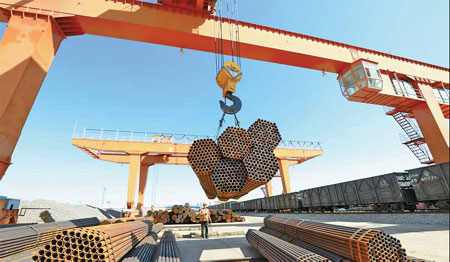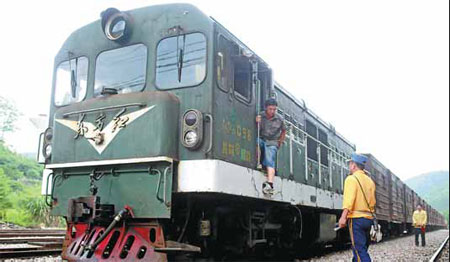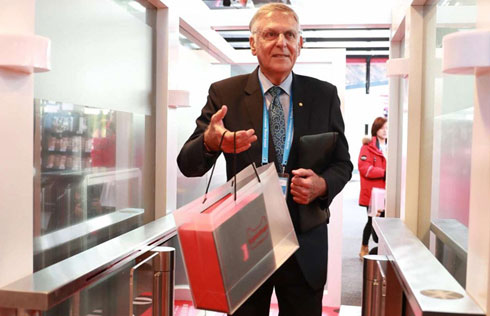Getting freight traffic back on the rails
|
Workers load steel goods at Wangjiaying West Railway Station in Kunming, Yunnan province. Cargo transport reforms have boosted the development of China's logistics industry. Wang Jianyun / for China Daily |
|
A freight train in operation in Yunnan province. Feng Yongbin / China Daily |
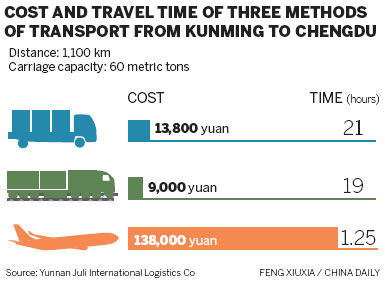
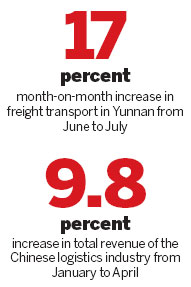
New rules governing cargo transport and reform of the former Ministry of Railways have given logistics companies new heart, reports Hu Yongqi in Kunming.
Niu Huiyong has been running Xinyang Storage and Transportation Co in Henan province for more than 20 years. In his opinion, the railway used to be a curate's egg, good in parts: While the extensive network made it possible to ship freight to remote destinations, the time-consuming process of booking space on the train, loading the goods and awaiting confirmation of delivery was always a source of disappointment and frustration.
Niu recalled an experience from 1993 when he applied to ship 1,000 metric tons of rice from Henan to Sichuan province via the railway. Unfortunately, the goods were delayed at the station for two months and the client threatened to sue Niu for breach of contract. The case never came to court, but the added silver lining for Niu was that during the time the goods were delayed, the price of rice rose by 20 percent, earning him an extra 40,000 yuan ($6,500) in profit.
"I wasn't really very grateful to the railway for the additional income, though, because that was a one-in-a-thousand event. Usually, the delays resulted in lost profit and credit," said Niu.
In July, however, Niu's attitude toward the railway changed markedly after the carrier instigated reforms. For the first time in Niu's experience, the paperwork was completed quickly and the goods were loaded and en route to the destination in a single day, an unheard of development.
On June 15, China Railway Corp introduced a reform aimed at improving efficiency and providing a better service. The reform was part of a plan to transform the railway freight sector into a modern logistics industry, one characterized by easier, faster service and lower prices.
A month after the reform, freight volumes began to rise, turning around years of declines. Kunming Railway Bureau alone transported 1,061 freight cars during the second half of June, an increase of 9.2 percent from the first two weeks of the month. Things continued to improve in July, when an average of 2,485 freight cars traveled by rail every day, a month-on-month increase of 17 percent, according to the bureau.
Having been given a taste of the new order, many logistics companies hoped to see the reform improve the service permanently, as predicted by transportation experts.
Market-driven reforms
Freight transport has contributed a huge amount to railway revenues for many decades, but the volume of rail freight shrank in the second half of last year as a consequence of China's economic slowdown and fierce competition from air carriers and trucking companies, according to a source with the Kunming Railway Bureau, who spoke on condition of anonymity.
From January to April, the volume of rail freight nationwide dropped 1.5 percent compared with the same period in 2012, but the total revenue of the Chinese logistics industry rose 9.8 percent from the previous year, according to the China Federation of Logistics & Purchasing.
In March, the former Ministry of Railways was split into commercial and administrative arms, namely China Railway Corp and the State Railways Administration, which was merged with the Ministry of Transport. The CRC took on the former ministry's debts, which totaled 2.79 trillion yuan, according to a ministry audit in 2012. The optimum time for CRC to repay the debt, estimated to arrive in four or five years, also pushed the corporation to carry out market-oriented reforms to improve profitability.
Compared with other methods of freight transport, such as air or road, the lower price charged by the railway gave it a unique advantage. Rail freight is 5 to 10 yuan cheaper per metric ton than road haulage, meaning a logistics company that carries 200,000 tons of freight annually can reduce its costs by at least 1 million yuan.
However, logistics companies complained that the cost advantage had been undermined by other charges, such as service fees, and the complicated booking procedures prior to the reform.
During the era of the planned economy, rail transport was a scarce resource and businesses had to request, or sometimes even plead, for freight to be transported. Moreover, the authorities charged a service fee of 10 to 30 yuan for each ton of freight carried, plus storage fees if clients didn't claim their goods on schedule.
"Before the reform, my company was required to submit transport plans for each week, month and season, to the railway station. It took at least 30 days to get approval for freight and there were a lot of procedures to go through, such as submitting a booking application, identifying and claiming the carriages and loading them," said Zhou Houjun, general manager of Shunhe Transport Co in Kunming, the capital of Yunnan province.
Zhou said that now, as long as the goods arrive at the railway station on time, they will be subjected to a security check and then loaded immediately. No other measures are required.
Dai Chaojian, manager of Yunnan Juli International Logistics Co, said his company used to submit preliminary plans to the railway station, clearly specifying how much freight would be transported during the next month, season and year.
"The railway was called 'Big Brother' in the transport industry, as it had a huge nationwide network. Therefore, all the goods had to be clearly listed in our paperwork. But usually only about 50 percent of the requested freight would be approved for transportation," Dai said.
After the reform, Dai noticed a huge change. "The process has been shortened and now it only takes a day to submit an application and load the goods onto the train," he said.
The improvement in efficiency means that Dai's company expects to transport 200,000 tons of freight this year, a year-on-year increase of more than 60 percent. "My company transports 30,000 tons of iron and steel every month and usually 40 percent of the total is shipped by rail. However, the proportion rose to 90 percent in July," said Dai.
For some clients, the higher price of road transport isn't an issue. "Time is crucial in the logistics industry and our clients don't care much about the extra expense of using the highway. They will lose much more if iron and steel prices surge, and they do fluctuate constantly, often by as much as 300 to 400 yuan per ton," added Dai.
Change of attitude
Li Fan, director of the freight service division at Luliang Railway Station in Kunming, visited 30 local companies during late June and July to introduce the new policies set in place after the reform and to canvass for new customers.
Because of the complicated procedures involved in rail freight, Yang Liuhua, general manager of Huasheng Flour Plant Co in Luliang county, decided to give up on the railway and use road transport, even though it costs more.
Late last month, Li paid Yang an unscheduled visit. "I couldn't believe the railway station actually sent someone to talk with me. In the past, they were the boss and I had to plead to have goods carried to the destination," said Yang.
After two hours of discussions, Li convinced Yang to give the railway another chance by emphasizing the advantage of the lower cost, said Yang. As of July 31, the Kunming Railway Bureau had signed contracts with 12 major local companies in the iron and steel, coal and tobacco industries.
Wangjiaying West Railway Station, a transfer hub located in a suburb of Kunming, generated revenue of 790 million yuan in the period from January to July and expects revenue of 1.4 billion yuan by December, a rise of about 40 percent year-on-year, said Tang Guizhuang, the station's director.
Adhering to the reform, Tang used 15 of his 253 workers to establish a new marketing and services department to find and attract new clients. There are five ways to book the service, the two most popular being the phone and the Internet. Each member of the marketing and service department is mandated to visit and persuade a targeted company to ship its goods by rail.
Since June 15, the station has transported 18,000 tons of freight every day, a notable increase from the 1,200 tons carried during the same period last year. "The increase in cargo volume and revenue can be attributed to the reform. It made us adopt a customer-friendly model for freight transport," said Tang, who added that staff members have been instructed to accept certified goods the minute they arrive.
The changes have also seen an increasing number of non-corporate customers using the rail network to transport commodities or personal goods.
"Large-scale commodities have always been our primary business. Last year, they accounted for 90 percent of our total freight volume. However, individual items have increased since the reform and now account for 50 percent of the freight we transport. In 2012, the number was much lower, around 10 percent," said Tang.
"Private customers are usually much more concerned about when the goods will arrive, and the rising number of contracts with individuals indicates that the service is being used by new customers."
Tang is confident that the lower charges will swell customer numbers and raise transport volume, even though the station stands to lose at least 10 million yuan per annum because the per-ton service fee has been canceled at the request of the CRC.
"To put it in a very simple way, the companies used to treat us to dinner. But now, we have to invite them for dinner. The relationship has changed fundamentally as clients have become 'gods', as the market demands," said Tang.
Door-to-door strategy
The CRC has simplified the acceptance procedures and optimized the mode of transport on demand. Sheng Guangzu, a former railways minister and now general manager of the CRC, told an internal meeting that a "door-to-door" freight transport service will soon be established. The service will allow customers to hand over their goods to railway workers, who will then take them to the recipient's house or office.
The door-to-door strategy will not just focus on large-scale commodities such as coal, minerals and construction materials, but also on individual items, according to the source within the Kunming Railway Bureau. If the strategy proves to be successful, the rail freight market will be able to compete with other modes of transport, the source said.
Transport over "the last 1 kilometer" by road is the CRC's Achilles' heel, and will determine the efficiency and quality of the door-to-door service, according to Sun Lijun, president of the school of transportation engineering at Tongji University in Shanghai.
Moreover, although the CRC reforms have not raised the price of rail freight, the company will be forced to accept price fluctuations as a necessary evil if it's really determined to follow a market-oriented model. Customers are now waiting to see the effects of the reform and any new moves from the CRC.
"The biggest change is the new attitude toward the clients. Now railway workers accept us as a source of income and the service is far more pleasant," said Dai. "As long as the railway authorities are determined to provide a high-quality service, I believe they can do it, no matter how hard it may be. The question is: how long can they keep it going?"
Contact the writer at huyongqi@chinadaily.com.cn
Li Yingqing and Guo Anfei contributed to this story.
(China Daily 08/08/2013 page6)






